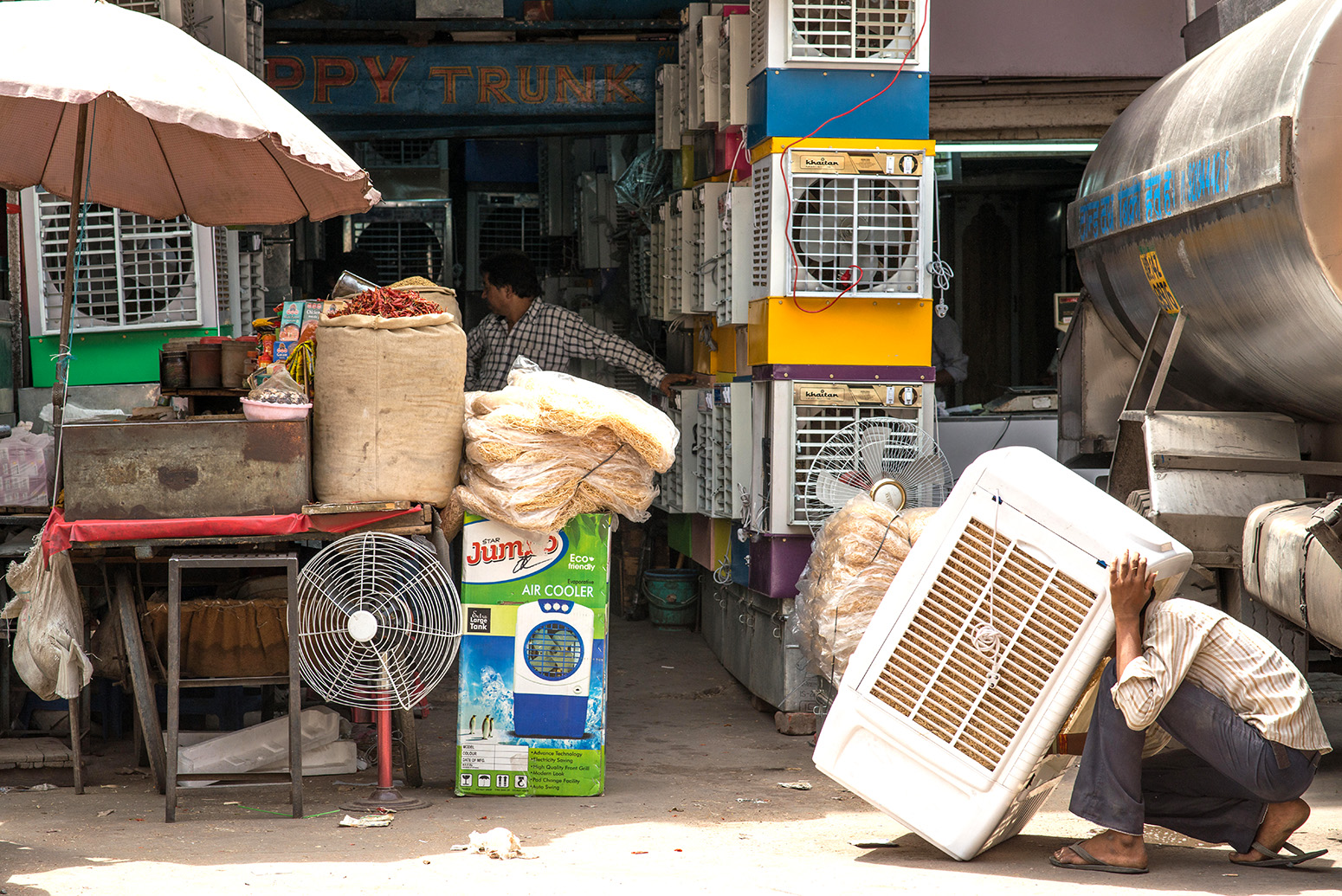隨著破紀錄夏季高溫襲擊北半球,低溫技術對人們生活品質、生產力和環境的重要性不言而喻。涼爽的建築物和車輛、工業過程中的冷卻和確保食藥品安全的「冷鏈」(低溫物流)已然成為必需品。
隨著地的球越來越熱,加上數億人口開始買得起第一台空調,主要的開發中經濟體的低溫技術需求將會飆升,若不妥善管理,可能會導致溫室氣體排放激增,阻礙我們因應全球暖化的能力。
幸好,這個問題存在解決方案。高效、乾淨的低溫技術發展可以對巴黎協定的1.5℃和2℃目標有所貢獻。這些暖化限制目標亦作為低溫技術需求的檢查標準,減少其帶來的暖化挑戰。

在暖化世界中降溫
在暖化的世界中,低溫技術並不是奢侈品:弱勢群體依靠它取得營養的食品、安全的藥品、生產力和防止熱傷害。
在炎熱氣候下的貧困農村社區,約4.7億人無法取得電力,無法獲得傳統的空調和保冷技術,包括運輸溫度敏感物品(如藥品)的「冷鏈」,或者以最小耗能將食物從農場送到餐桌。缺乏低溫技術可能限制健康、農業生產力和經濟自給自足的機會。
為滿足人類消費所生產的糧食,有三分之一被拋棄或浪費,因而產生的土地利用和溫室氣體排放是可是先避免的。缺乏電力供應的小農承受高得不成比例的食品供應鏈損失,至少是最高效率供應鏈的兩倍。不完整和不健全的低溫物流是造成這種損失的關鍵因素。
最炎熱的城市中,收入最低的6.3億人-通常居住品質也較差-可能只能偶爾享用低溫技術,甚至無法負擔。這可能影響食品安全,讓人為氣候變遷帶來的熱浪更難以適應。
能源系統的挑戰
今日全球有16億個住宅空調正在使用中。而炎熱國家的大多數家庭尚未購買第一台空調,到了2050年,全球住宅空調可能增加到56億個。
隨著能源效率標準逐步提高,空調發展如果沒有任何改變,能源需求可能在本世紀中葉增加兩倍,達到6,200兆瓦時(TWh),相當於今日所有用途的全球電力消耗的四分之一以上,可能需要約3.2兆美元的發電投資。
大熱天空調需求會對電網造成很大壓力。兩年前北京的夏季,建築物降溫佔每日峰值電力需求的一半以上。
在印尼和印度,空調需求若照舊成長,到了2050年,空調佔峰值電力需求將從今日的10-15%成長到超過40%。在印度的部分城市,空調佔每日電力峰值已經超過60%。
今天未滿足的冷卻需求遠不止建築物空調、冷鏈、運輸和工業。考量更廣泛的用途,同時確保保護弱勢群體免受極端高溫和冷鏈損壞的影響,即使納入更積極的能效和需求反應標準,2050年的能源需求仍可能高達15,500兆瓦時,佔當今全球電力需求的三分之二。
溫室氣體排放
目前的傳統冷卻技術,包括空調和製冷,都依賴人造製冷劑,通常是氟化(F)氣體,如氫氯氟烴(HCFCs),其全球暖化效力可達二氧化碳的10,000倍。
如果不加以控制,到2050年,含氟氣體可能佔溫室氣體總排放量的近20%,可知為什麼根據蒙特婁公約吉加利修正案,將前一代含氟氣體逐步減少,對限制全球暖化是如此重要。
冷卻用電龐大且需求不斷增長-在主要市場通常透過煤電-意味著它對減少用電碳排放構成嚴峻的挑戰。
2017年,連接到全球電網的住宅空調用電估計為100千兆瓦 ,超過了當年創紀錄的太陽能發電量94千兆瓦。這顯示冷卻用電成長若未經管理,可能讓化石燃料發電難以減少。
系統性解決方案
最快的方法是導入並落實更嚴格的能源效率標準。採用當今市場上最高能效標準,可將2050年空調能源需求減半。
如果全世界要實現氣候目標,同時確保冷卻技術普及,也可能需要找到減少依賴傳統低溫技術的方法,包括「響應式」冷卻設備和冷藏的混用,以管理高峰電力需求,以及更智能化的建築規範,包括被動冷卻設計和更能避熱的都市規劃。
也有簡單的解決方案,例如反射性更好的「冷屋頂」,以及城市區域供冷能源系統和偏遠地區的獨立型系統。
提供這些解決方案需要相應監管、財務和商業模式,像是「冷卻即服務」,需因國家和地方環境制宜滿足冷卻要求。
關鍵的第一步是認識到低溫技術的戰略意義,不僅與氣候危機緩解對暖化的抵禦能力有關,也跟安全和繁榮有關。
As records tumble across Europe in a second heatwave of the summer and as people across China and North America are also feeling the heat, we can literally sense how influential cooling is for our wellbeing, productivity and environment.
Cool buildings and vehicles, as well as cooling in industrial processes and "cold chains" that ensure our food and medicines are safe, are things we either take for granted or increasingly come to expect.
With demand for cooling expected to soar in major developing economies as the world becomes warmer and hundreds of millions of people become able to afford their first air conditioner, unmanaged cooling growth could cause a surge in greenhouse gas emissions and hamper our ability to manage global warming.
Yet solutions to this challenge do exist. Efficient and clean development of cooling can make a significant contribution towards respecting the 1.5C and 2C Paris temperature limits. Moreover, those limits can check the need for cooling, reducing the scale of the challenge it poses.
Cooling in a warming world
In a warming world, access to cooling is not a luxury: vulnerable populations depend on it for nutritious food, safe medicines, productivity and protection from extreme heat.
Some 470 million people in poor rural communities in hot climates lack access to electricity and therefore to conventional space cooling and refrigeration technologies. This includes "cold chains" for the transport of temperature-sensitive goods such as medicines, or getting food from farm to fork with minimal wastage. This lack of access to cooling can limit good health outcomes, agricultural productivity and opportunities for economic self-sufficiency.
Food loss and waste amounts to one third of all food produced for human consumption, placing avoidable pressures on land-use and associated greenhouse gas emissions. Smallholders lacking access to electricity disproportionately suffer supply chain losses of food, which are at least twice as high as in the most efficient supply chains. Incomplete and broken cold chains are a key contributing factor to this loss.
Some 630 million people on the lowest incomes in the hottest cities – often in poor quality housing – may only have intermittent access to cooling services or struggle to afford them. This can compromise food safety and exacerbate vulnerability to heat stress from increasingly frequent and intense heatwaves brought about by human-induced climate change.
Energy system challenges
There are 1.6bn residential air conditioners in use today. Most households in hot countries have not yet purchased their first air conditioner (AC), and ownership could rise to 5.6bn by 2050.
Business-as-usual development of space cooling, with incremental improvements in energy efficiency standards, means that energy demand for it could triple by mid-century to 6,200 terawatt hours (TWh). This is the equivalent to over a quarter of today's global power consumption for all uses and could require power generation investment of some $3.2tn.
On hot days, space cooling demand can place significant stress on power grids. Almost exactly two years ago during summer in Beijing, cooling for buildings contributed more than half of daily peak power demand.
In Indonesia and India, business-as-usual cooling growth would mean AC contributes over 40% of peak power demand over the course of a year by 2050, up from 10-15% today. Daily peaks already nudge 60% in some Indian cities.
Today's unmet cooling needs extend well beyond cooling buildings into cold chains, mobility and industry. Looking at this wider range of uses, while ensuring full access to cooling to protect vulnerable people from the effects of heat extremes and broken cold chains could mean energy demand as high as 15,500TWh in 2050 – two thirds of today's global power demand – even if aggressive energy efficiency and demand-response standards for cooling equipment were to be pursued.
Greenhouse gas emissions
Current, conventional cooling technologies, such as air-conditioning and refrigeration, rely on human-made refrigerants – usually fluorinated (F) gases, such as hydrochloroflourocarbons (HCFCs) – that can be 10,000 times more potent than CO2 in causing global warming.
Left unchecked, F-gases could account for nearly 20% of total greenhouse gas emissions by 2050. This is why the phase down of the current generation of F-gases under the Kigali Amendment to the Montreal Protocol – and its ratification by national governments – will have such important consequences for efforts to limit global warming.
Cooling's large and growing demand for electricity – in the major growth markets often generated with coal – means that it poses a serious challenge to reducing power sector emissions.
In 2017, the amount of residential AC load connected to the world's power grids – estimated at 100 gigawatts (GW) – exceeded that year's record addition of solar capacity, some 94GW. This suggests unmanaged cooling growth could play a significant part in keeping fossil-fueled sources of electricity on the system.
Systemic solutions
There are abundant solutions to managing cooling demand in a warming world, while allowing for increased access.
The most rapid option is the introduction and better enforcement of more stringent efficiency standards for equipment. Adopting standards equivalent to the most efficient AC available on the market today could halve halve 2050 energy demand for space cooling.
Finding ways to reduce reliance on "conventional" cooling is also likely to be needed if the world is to meet its climate goals, while ensuring access to cooling grows.
This could include a mix of "responsive" cooling equipment and cold storage to manage peak demand for electricity, as well as smarter building codes incorporating passive cooling design and cooler urban planning.
It also includes simple solutions such as more reflective "cool roofs" and shifting the delivery of cooling to district energy systems in cities and off-grid systems in remote areas.
Delivering these solutions will require regulation, finance and business models – for example "cooling as a service" – sensitive to national and local contexts and geared to meeting cooling requirements.
It will also mean including all those with a stake in the need for and provision of cooling services across environment, health, agriculture, productivity, innovation and trade.
The critical first step is to recognise the strategic significance of cooling, not only in relation to climate mitigation and resilience to warming, but also for security and prosperity.
※ 全文及圖片詳見:Carbon Brief (CC BY-NC-ND 4.0)








